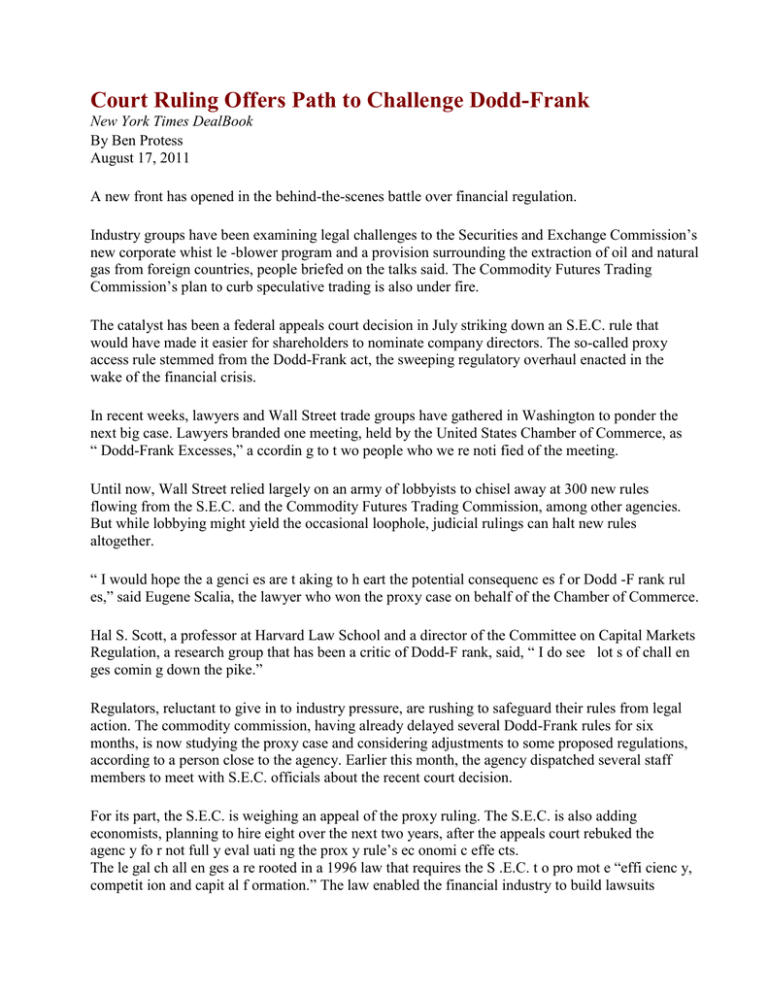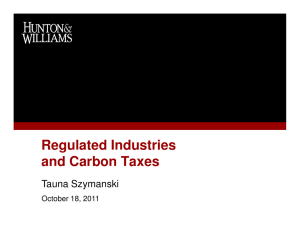Court Ruling Offers Path to Challenge Dodd-Frank
advertisement

Court Ruling Offers Path to Challenge Dodd-Frank New York Times DealBook By Ben Protess August 17, 2011 A new front has opened in the behind-the-scenes battle over financial regulation. Industry groups have been examining legal challenges to the Securities and Exchange Commission’s new corporate whist le -blower program and a provision surrounding the extraction of oil and natural gas from foreign countries, people briefed on the talks said. The Commodity Futures Trading Commission’s plan to curb speculative trading is also under fire. The catalyst has been a federal appeals court decision in July striking down an S.E.C. rule that would have made it easier for shareholders to nominate company directors. The so-called proxy access rule stemmed from the Dodd-Frank act, the sweeping regulatory overhaul enacted in the wake of the financial crisis. In recent weeks, lawyers and Wall Street trade groups have gathered in Washington to ponder the next big case. Lawyers branded one meeting, held by the United States Chamber of Commerce, as “ Dodd-Frank Excesses,” a ccordin g to t wo people who we re noti fied of the meeting. Until now, Wall Street relied largely on an army of lobbyists to chisel away at 300 new rules flowing from the S.E.C. and the Commodity Futures Trading Commission, among other agencies. But while lobbying might yield the occasional loophole, judicial rulings can halt new rules altogether. “ I would hope the a genci es are t aking to h eart the potential consequenc es f or Dodd -F rank rul es,” said Eugene Scalia, the lawyer who won the proxy case on behalf of the Chamber of Commerce. Hal S. Scott, a professor at Harvard Law School and a director of the Committee on Capital Markets Regulation, a research group that has been a critic of Dodd-F rank, said, “ I do see lot s of chall en ges comin g down the pike.” Regulators, reluctant to give in to industry pressure, are rushing to safeguard their rules from legal action. The commodity commission, having already delayed several Dodd-Frank rules for six months, is now studying the proxy case and considering adjustments to some proposed regulations, according to a person close to the agency. Earlier this month, the agency dispatched several staff members to meet with S.E.C. officials about the recent court decision. For its part, the S.E.C. is weighing an appeal of the proxy ruling. The S.E.C. is also adding economists, planning to hire eight over the next two years, after the appeals court rebuked the agenc y fo r not full y eval uati ng the prox y rule’s ec onomi c effe cts. The le gal ch all en ges a re rooted in a 1996 law that requires the S .E.C. t o pro mot e “effi cienc y, competit ion and capit al f ormation.” The law enabled the financial industry to build lawsuits around the economic costs of a rule, regardless of its merits. In 2005, the Chamber of Commerce was the first business group to invoke the law, using it to successfully challenge certain S.E.C. rules for the mutual fund industry. The chamber later gained momentum with a string of similar victories in the United States Court of Appeals for the District of Columbia Circuit. Altogether, the appeals court has tossed out three financial regulations in the last six years, including the proxy rule. Mr. Scalia, a partner at the law firm Gibson Dunn and the son of Supreme Court Justice Antonin Scalia, was on the winning end of each case. Banks and corporations, rather than challenging the rules directly at the risk of alienating regulators, turn to seasoned litigators like Mr. Scalia and influential trade groups like the Chamber of Commerce to lead the fight. For more than 30 years, the chamber has had a separate litigation center, which operates as its own law firm in Washington. “ It i s usu all y not i n the in terest of a sin gle business to m ount a claim,” said Brian G. C artwri ght, the S.E.C .’s former gen er al counsel who now wo r ks at the law firm Lath a m & W atki ns. “You need some cut-out m an o r or ganiz ati on that speak s for broad groups.” The industry has shied from mounting a broader challenge to Dodd-Frank itself, finding it cheap er and easier to gra duall y chip awa y at t he law’s fiercest provisions. Lawyers say a single lawsuit contesting the constitutionality of Dodd-Frank could take years — and millions of dollars — to wind through the courts, with little chance of succeeding. “Dodd-Frank is not one t hing but m an y,” said M a rgare t E. Tahyar, a partner at the law firm Davis P olk. “There is no reasonabl e const it uti onal or statutor y chall en ge on the whole — only on the bits and pieces.” By some measures, the proxy rule was an unlikely choice to challenge on economic grounds. The S.E.C. produced 60 pages on a cost-benefit analysis of the rule and spent 21,000 staff hours drafting it over two years, Mary L. Schapiro, the a gen c y’s ch airwoman, s aid i n a rec ent l ett er to Congress. That the proxy regulation still did not pass muster does not bode well for several other DoddFrank rules that received considerably less explication, sometimes only 25 pages, on their economic effects. “The prox y case mak es a ll the rules open tar get t o chall en ge, ” Mr. Scott of Harva rd said. Financial trade groups, according to several lawyers, are now considering suits against the S .E.C.’s corporate whist le-blower office, which opened last week. The chamber, at least, argues that the whistle-blower program allows tipsters to undermine internal compliance departments. Industry groups are also looking at claims against a few more obscure Dodd-Frank provisions. One S.E.C. regulation requires companies to disclose whether they manufacture goods using socalled conflict minerals like gold from Congo. Tiffany & Company ar gu ed in a lett er to the S .E.C. t hat t he proposed rules “would viol ate the First Amendment,” la yin g the gro undwork fo r bus iness groups to mount a c onst it uti onal challenge. Some letters are even blunter, as groups invoke the proxy case as a cautionary tale. Royal Dutch Shell wrot e the S.E.C . thi s mon th about “our ex pected costs ” stemming from a proposal about oil ex tracti on. S hell fil ed the lett er, it said, “in l ight of the re cent decisi on b y the U.S. C ourt of Appeals.” The commodity commission has received a barrage of hostile letters, too, some foreshadowing legal action. In March, the Futures Industry Association urged the commission to scrap its plan for reini n g in sp ecul ati ve comm odit ies trading, sa yi n g it “ma y be l e gall y in firm.” Bart Chilton, a Democratic commissioner at the agency who has championed tough position limits on oil, corn and the like, sought f eedb ack o n the plan from t he C ME Group, the nati on’s largest futures ex change. But at C ME’s Chi ca go h eadquart ers last fall , ex ec uti ves decli ned to discuss the proposal with Mr. Chilton, saying the Commodity Futures Trading Commission lacked the legal authority to impose trading limits. With the industry firing such warning shots, regulators have spent months shielding their rules from litigation. In M a y, the Com modi t y Futures Tr adin g C omm iss ion’s gen eral counsel an d chief e c onomist issued a memo spelling out guidelines for cost-benefit analyses. The memo and other efforts to slow down the Dodd-Fra nk rules later dr ew r are p raise from the a gen c y’s i nternal watchdo g, which said the comm iss ion “has taken p roacti ve s teps to addres s con cerns. ” S cott O’Malia, a R epubli can comm iss ioner at t he futures tradin g comm iss ion, also call ed for th e agency to re-examine every cost-benefit analysis drawn up for Dodd-Fran k. “The comm iss ion does not have the final word, as the S .E.C. has re c entl y le arned, ” Mr. O’M ali a warn ed thi s month. Still, most regulators are hesitant to strike the panic button. “W e hear about pot enti al l awsuit s with som e freq uenc y,” Mr. Chi lt on said in an interview. “Ther e’s an old s a yin g in W ashingt on that, if you ’ re not part of the sol uti on , there’s plent y of mone y to be m ade bein g part of the problem. ”



